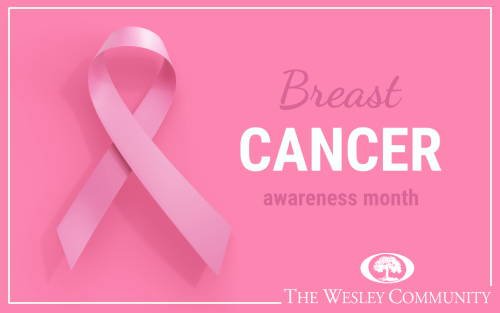Older women are at highest risk for developing breast cancer. Share this information with the senior women in your life today.

Throughout October, you’ll likely notice people across the country wearing pink. From T-shirts and hats to ribbons and bracelets, wearing pink is part of an effort to raise awareness about breast cancer. It’s the second most common type of cancer among women. For older women, it’s especially important to know the risk factors.
Senior women are at the highest risk for developing breast cancer. Between the ages of 60 and 70, 1 in 28 women will be diagnosed with the disease. After age 70, the risk becomes 1 in 26 women. That’s why it’s essential for women to have an annual mammogram or other screening test.
In honor of National Breast Cancer Awareness Month, we are helping to spotlight the statistics on breast cancer and the most common risk factors.
Breast Cancer among Older Women
Breast cancer rates rose during the mid– to late–1990s. Experts believe this may have been linked to the increased use of menopausal hormone therapy, which we now know contributes to breast cancer. Since that discovery, hormone therapy use has declined and so have breast cancer rates.
Other statistics that are important to know about older women and breast cancer include:
- Median age: The median age when a woman is diagnosed with breast cancer is 63.
- Age range: Research shows that the risk for breast cancer is 1.7 times higher for women older than 65 than it is for women between the ages of 45 and 64. It is 10 times higher than the risk for women 45 or younger.
- Incidence: Women have a 12 percent risk of developing breast cancer. That translates to 1 in every 8 women in this country.
Risk Factors for Breast Cancer
While some risk factors are unavoidable, such as age and genetics, others are not. By evaluating your and a senior loved one’s personal risk factors, you may both be able to lower the odds of a breast cancer diagnosis.
Here are some of the most common risk factors for breast cancer:
- Age: The older you are, the more likely you are to develop the disease. Risk starts to rise at 40 and is highest after age 70.
- BRCA genes: The BRCA1 or BRCA2 gene mutation significantly increases the risk of breast cancer. Women with either mutation have a 7 in 10 chance of developing breast cancer before the age of 80. The more people in your family with one of these mutations, the higher your risk.
- Age at childbirth: Women who have given birth to their first child by or at age 35 have lower risk, as do those who have more than one child.
- Alcohol consumption: Women who consume 2 or 3 alcoholic drinks a day increase their breast cancer risk by as much as 20 percent.
- Birth control usage: Taking or recently stopping birth control pills also impacts the chance of breast cancer. Those who are on or recently stopped taking birth control pills have a 20 to 30 percent higher risk than women who’ve never taken them.
- Weight: This one is a bit tricky. Being overweight before menopause slightly decreases a woman’s risk for breast cancer. After menopause, being overweight increases it.
- Exercise and activity: A sedentary lifestyle combined with a lack of exercise increases breast cancer risk. Senior women who sit less and exercise regularly may be able to reduce their threat by as much as 20 percent.
You can help create greater awareness about breast cancer, a disease that claims nearly 43,600 lives a year, by sharing this article with the women in your life.
Follow The Wesley Community Blog
Whether you are a senior, a family caregiver, or a health care professional, we encourage you to bookmark our Senior Strategies blog. We update it several times each month with information related to healthy aging, senior living, elder care, and more!

